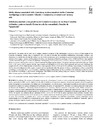Identificador persistente para citar o vincular este elemento:
https://accedacris.ulpgc.es/jspui/handle/10553/5535
| Título: | Ichthyofauna associated with Cymodocea nodosa meadows in the Canarian Archipelago (central eastern Atlantic): Community structure and nursery role | Autores/as: | Espino Rodríguez, Fernando Tuya, F. Brito, A. Haroun, R. J. |
Clasificación UNESCO: | 240106 Ecología animal | Palabras clave: | Cymodocea nodosa Seagrass meadows Islas Canarias Canarian archipelago Praderas marinas |
Fecha de publicación: | 2011 | Publicación seriada: | Ciencias Marinas | Resumen: | We carried out 84 trawls in 41 seagrass meadows composed of the phanerogam Cymodocea nodosa at three islands of the\nCanarian Archipelago, during June to September 2003, in order to describe the associated ichthyofauna (composition, richness, and\nabundance), to analyze the role that this habitat can play in fish recruitment, and to determine the potential relationship between the spatial\nstructure of the seagrass meadow and the patterns of richness and abundance of the fish assemblage. A total of 8298 individuals were captured.\nThe five most relevant species, in terms of abundance and frequency, were Spondyliosoma cantharus, Diplodus annularis, Syngnathus typhle,\nMullus surmuletus, and Pagellus erythrinus. Gran Canaria had the largest species richness (36 species) and mean number of species per sample\n(8.69 ± 0.49; mean ± SE). Lanzarote had the largest number of individuals (64.83% of the total registered) and mean total abundance per\nsample (168.39 ± 30.91). High densities of individuals were registered (95.86 ± 13.5) and 92.91% of fishes were juveniles. Our data showed\nthat the physical configuration of the seagrass meadows did not significantly affect the patterns of richness and abundance of the associated fish\nassemblage. In conclusion, the C. nodosa meadows exhibited a singular ichthyofauna and they contribute to the maintenance of the diversity of\nthe coastal fish assemblages in the Canarian Archipelago. This habitat constitutes, during spring and summer, a nursery habitat for juvenile\nfishes of many species, several of them commercially targeted. | URI: | https://accedacris.ulpgc.es/handle/10553/5535 | ISSN: | 0185-3880 | DOI: | 10.7773/cm.v37i2.1720 | Fuente: | Ciencias Marinas [ISSN 0185-3880], v. 37 (2), p. 157-174 |
| Colección: | Artículos |
Citas SCOPUSTM
38
actualizado el 08-jun-2025
Citas de WEB OF SCIENCETM
Citations
38
actualizado el 08-jun-2025
Visitas
70
actualizado el 06-ene-2024
Descargas
104
actualizado el 06-ene-2024
Google ScholarTM
Verifica
Altmetric
Comparte
Exporta metadatos
Este elemento está sujeto a una licencia Licencia Creative Commons

